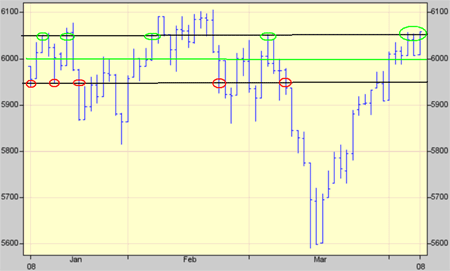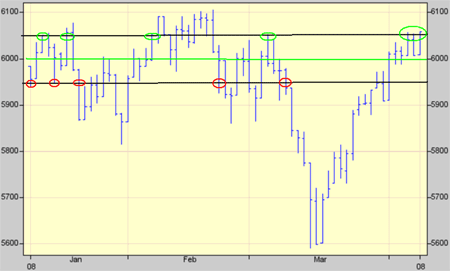It's time to bet against this crowded trade
Having been on the right side of the FTSE's recent bounce, Bengt Saelensminde reckons the smart money's now to be made betting the other way. Here, he explains how.
We've been on the right side of the FTSE's recent bounce... but it's a crowded trade now - and I reckon the smart money's to be made betting the other way.
Theoil price has broken above $120; there's more trouble in Europe; and there's a lingering concern over Japan. All these could be bad for stocks.
Our latest long-FTSE' trade was a belter. BUT when everything looks great and you've pocketed a good win, you'd better have a look at it from the other side.
MoneyWeek
Subscribe to MoneyWeek today and get your first six magazine issues absolutely FREE

Sign up to Money Morning
Don't miss the latest investment and personal finances news, market analysis, plus money-saving tips with our free twice-daily newsletter
Don't miss the latest investment and personal finances news, market analysis, plus money-saving tips with our free twice-daily newsletter
Marketsmove up and down - like the ebb and flow of the tide. A strategy to play both sides can be a great move. So that's what I've been working on.
6000 has established itself as a key level for the FTSE. The market doesn't want to drift too far either side of it. Though frankly, after the market meltdown from the recent global crises, I began to wonder whether the market had decided to breakout of its range.
Well, of course it did. But the fact that we're straight back to that key 6000 level is incredibly important. It just goes to show what a powerful trading range we've got here. Take a look at this chart:
3-Month High-Low FTSE 100

Source ADVFN.com
The green line at the 6000 level is the key to this trade. I've drawn in two tramlines 50 points either side of it. Buy low (red circles) and sell high (green circles).
I hope that I persuaded you to buy into this rally. But now for the tough part... I want you to do the opposite. I want you to sell the FTSE at anything over 6050 (like it is right now). We're betting on the FTSE falling.
I know going short' may not come easily to you. And you're right to be sceptical. You should only ever short with care. Take a look what can happen if you get it wrong...
The dangers of unlimited downside...
Say you agreed with my idea a few months ago that HMV was in trouble. You may have opened a short at 26p. With a bet of £10 per point, the most you could have won was £260 - that's if HMV fell to zero - i.e. goes bust.
But what if (by some amazing feat) HMV rose like Lazarus from the dead. It wasn't going to happen, but technically it could have reached back up to the £5 mark - 474 spread betting points higher than your entry. At £10pp you'd have been looking at a loss of... £4,740. Now that's got to be worth bearing in mind.
As it happened, HMV's share price halved - and the bet paid out £130 (£10 x 13p).
This example highlights an important point. HMV halved and gained £130. Had HMV doubled, we'd have lost £260... that's worth noting.
And there's one more thing you need to know. Shortspread bets aren't a good long-term strategy. Stocks are more likely to go up than down over time (it's to do with the time value of money). That's just the way it is. Bull markets generally go on for longer than bears.
If you're long a stock, you expect to get paid dividends. And the opposite is true if you're short. A short position means that you've got to pay out any dividends on the stock - even with a spread bet. When the stock goes ex-div there'll be an adjustment - you'll get charged the amount of the dividend paid out. That adjustment is incorporated into the short FTSE contract too. Basically, it costs you money to finance a short.
So if you're going to short, you need to have a very good reason to do so. And that's what I think we have today.
We're in a schizophrenic market
It may be that the tremendous recent market run will put you off shorting, but that's exactly why I think you should pounce now. Don't wait until the market has already made its move down.
On Monday I described a rather worrying new dimension to the market. Robotic trading based on the charts. And I sense some over-excited micro-processors behind this rally.
Remember, the fundamental players will have their day in the sun too - when bad economic news hits, the markets will get marked down again. I won't bore you with the finer details of why the markets - especially in the UK - look vulnerable, but let's just say the economy is hardly a bed of roses right now.
And anyway, once the computers think its time to sell - they'll bail out too... the automatons have no compunction about bailing - there's no emotion. "Computer says no" and the order is in the system quicker than you can blink and that's no exaggeration - we're talking milliseconds.
So how are we going to play this? Let me show you the strategy...
How to profit as the FTSE falls
Here's that chart again.
3-Month High-Low FTSE 100

Source ADVFN.com
My previous strategy was to buy low sell high. And I'm sticking to that. The only difference is, instead of starting with a buy (red circle), I'm going to start with a sell (green circle).
If your portfolio is anything like mine, it'll be mainly long - you'll have reasonable exposure to the FTSE. That's why I'm not too worried about putting on this short. Let's say you've got a £100k long-only portfolio and you place a FTSE short of £1per point.
That down bet at 6050 effectively gives you a short exposure of £6,050. A £10pp bet exposes you to £60,500 - you get the idea. Thinking about it in these terms should help you gauge the size of the bet you should make.
If you decide to put on a £1pp short and the FTSE moves in the wrong direction (i.e. up) then at least the rest of your portfolio should outweigh your losses. What we're talking about here is a hedge.
And remember I said you shouldn't use shorts for long-term trades as you'll have to pay to finance it. Well, I'm not expecting this to be a long-term trade. The FTSE is just too volatile right now - whether we win or lose, we're likely to find out pretty soon.
Make sure you place your exit orders
The FTSE is above 6050 as I write, so you can enter the trade. But if when you read this the FTSE is already below our 6050 entry level, place a limit order' to sell at 6050, good till cancelled'.
I want to maintain the stop-loss on this trade at 150 points. If you open at 6050 and the market moves up to 6200, you'll get closed out. You'll lose 150 points multiplied by your stake. Set your stop loss 150 points above whatever your entry price is.
Once you're in the trade, remember to place a limit order' to buy at 5950, making sure it's good until cancelled'. If the market runs to form, you'll automatically close out when the market falls back to 5950, pocketing 100 points... and hopefully we should be able to repeat the trade again and again. Looking at the last 3 months, you could have had 4 wins before the chart broke out.
But at some point the chart will break out. We need to watch that - and it's why your stop loss is crucial... in case it breaks to the upside - we want to get out.
If the chart breaks to the bottom - we'll be safe (we'll have closed out at 5950). If however, the chart breaks up above the 6200 mark, we'll get closed out too - with a 150 point loss!
So let's hope the FTSE stays on form. If so, we should be able to squeeze in a few successful trades before the breakout.
I hope you're enjoying these spread betting ideas. For more ideas, check out my friend John Burford. His free MoneyWeek Trader email is a great resource for trading tricks and ideas. Add your name to his list here.
And I'll be back with you on Monday with a new idea. If you have any thoughts or ideas you want me to write about, do get in touch.
Happy trading,
P.S. That report I sent Right Side email readers yesterday on Paul's strategy of picking up "bombed out" stocks and cashing in on the rebound got a great response! It seems like Right Siders are up for a bit of risk taking for high reward potential. If you missed it, find out what Paul's idea is today - he's been honing this for 20 years:
This article was first published in the free investment email The Right side. Sign up to TheRightSide here.
Paul Hill's Preceision Guided Investments is a regulated product issued by MoneyWeek Ltd. Forecasts are not a reliable indicator of future results. Your capital is at risk when you invest in shares, never risk more than you can afford to lose. Please seek independent financial advice if necessary. 0207 633 3780.
MoneyWeek Trader is an unregulated product published by MoneyWeek Ltd.
Important Information
Spread betting is not suitable for everyone - ensure you fully understand the risks involved and never risk more than you can afford to lose. Spread betting carries a high level of risk to your capital. Prices can move rapidly against you and resulting losses may be more than your original stake or deposit. Margin amounts vary between spread betting companies and the type of markets spread bet.
Commissions, fees and other charges can reduce returns from investments. Profits from share dealing are a form of income and subject to taxation. Tax treatment depends on individual circumstances and may be subject to change in the future. Please note that there will be no follow up to recommendations in The Right Side.
Managing Editor: Frank Hemsley. The Right Side is issued by MoneyWeek Ltd.
MoneyWeek Ltd is authorised and regulated by the Financial Services Authority. FSA No 509798. https://www.fsa.gov.uk/register/home.do
Get the latest financial news, insights and expert analysis from our award-winning MoneyWeek team, to help you understand what really matters when it comes to your finances.
Bengt graduated from Reading University in 1994 and followed up with a master's degree in business economics.
He started stock market investing at the age of 13, and this eventually led to a job in the City of London in 1995. He started on a bond desk at Cantor Fitzgerald and ended up running a desk at stockbroker's Cazenove.
Bengt left the City in 2000 to start up his own import and beauty products business which he still runs today.
-
 ‘Why I have ditched my Help to Buy ISA for cash savings and the stock market’
‘Why I have ditched my Help to Buy ISA for cash savings and the stock market’Without the 25% bonus, my Help to Buy ISA is effectively redundant, says MoneyWeek writer Sam Walker.
-
 Is your inheritance tax allowance cut if you sell to downsize or sell your home to pay for care?
Is your inheritance tax allowance cut if you sell to downsize or sell your home to pay for care?Downsizing relief is a little-known benefit that could save your loved ones tens of thousands of pounds in inheritance tax after you’ve died.